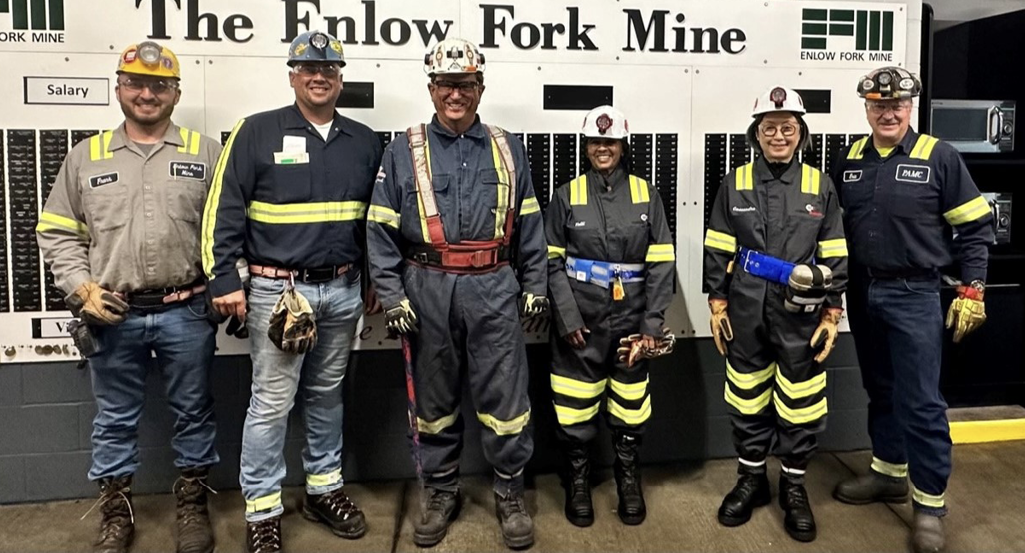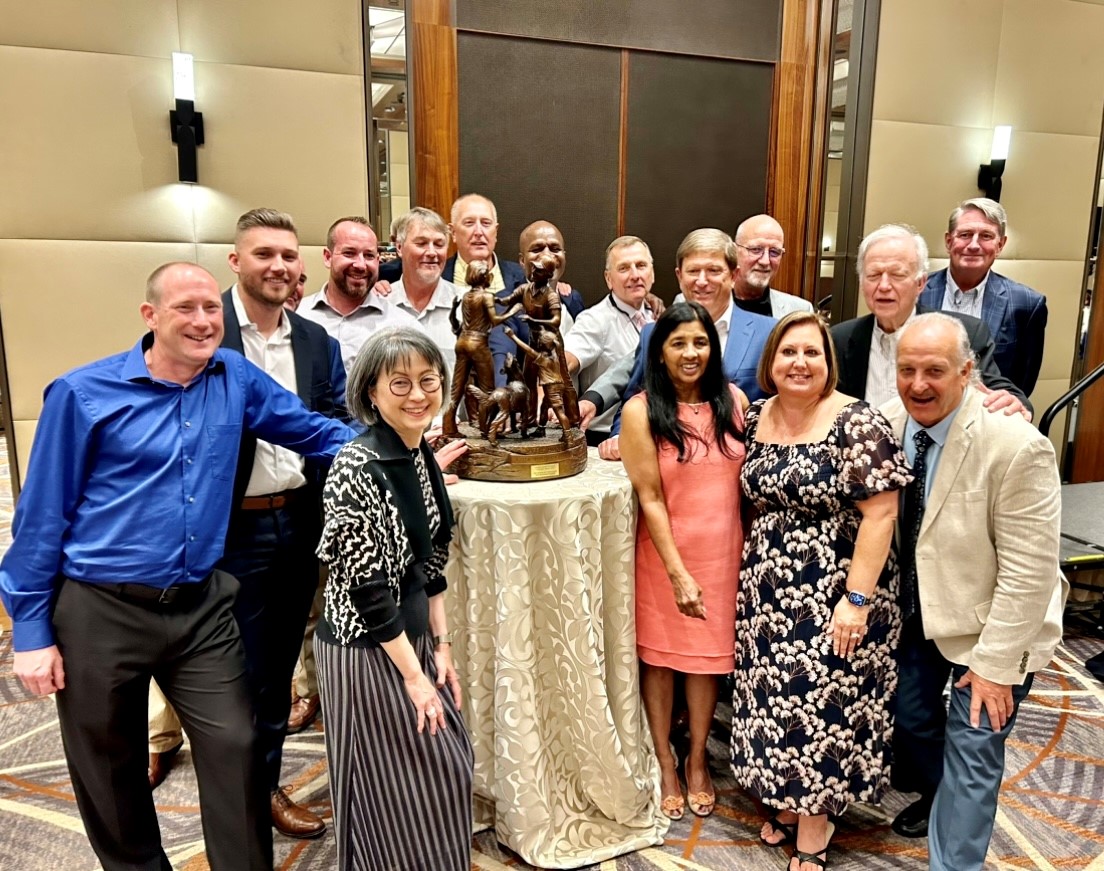Amid the transformation of coal over the last few decades, one coal magnate’s face has remained a constant: CONSOL Energy’s Jimmy Brock. As he moved through the ranks to become the coal operating company’s chief operating officer, his strategic insight has helped shape the Appalachian coal industry. In this issue’s bonus executive Q&A, Brock shares more about his background, his vision for the company and even his market outlook both domestically and globally.

NAM: Thanks, Jimmy, for talking with NAM. Tell us more about your career in mining through today and what originally brought you to mining.
Brock: I was teaching tennis in my hometown in Middlesboro, Ky., instructing the wife of the human resources supervisor (I did not know the relationship at the time). It was the summer before heading back to school to earn money for college expenses. The husband asked me what I was going to do for work the next summer and I replied, “Most likely teach tennis again, as I am doing now.” He asked me if I was interested in working for CONSOL as a summer student. I said I would think about it. He reached out to me and told me about the benefits and long-term opportunities for a career in mining with CONSOL Energy.
The mine was 18 miles from my house, and I decided to accept the summer intern position. The first time I went underground, I wasn’t sure it was for me, but I was so fortunate to be surrounded by excellent people who took me under their wing and taught me how to work safely and to pay attention to the surrounding work environment. I began to enjoy it more every day, and before the summer was over, I knew I would be back!
I accepted a full-time position in 1980 as an environmental engineer and worked underground monitoring dust and learning as much as I could. Every aspect of mining was very interesting to me, and I wanted to learn it all. These men and women worked very hard and were proud of what they did and how they performed their daily jobs. As I worked my way up through the ranks, I gained more respect for these amazing people. I have been very fortunate to start out as an hourly worker cleaning conveyor belts and end up in my current position as chairman and CEO of the same company I started with as a summer student.
Accomplishments are rarely, if ever, accomplished alone, and I was surrounded by some of the best people in the business to help me get here.
As I moved from location to location in my career, I have met some of the best people in the world and I truly believe mining people are the all-around best.
How has your time in the industry shaped how you work today, and how the company operates?
My time in the industry has taught me how to respect and appreciate the hard-working people that produce a vital product for our nation, which is used in many ways we all take for granted. As a results-driven leader, I know this was instilled in me from observing the hard work and pride the miners had in what they did every day.
I try to spend as much time as possible with our employees and be as transparent as I can with them. I try to keep them informed on how the company is doing and where we are headed in the future. This is important and it builds morale throughout the workforce. We manage our company by our core values, which are Safety, Compliance, and Continuous Improvement. Safety is at the forefront of everything we do, and our employees are empowered to stop anything they believe jeopardizes their safety or a co-worker’s safety. They have a discussion and either correct the problem or change how they perform the job task. We strive to be compliant with all safety policies, regulations, and job procedures. We are always looking for ways to improve from a productivity and efficiency standpoint. We constantly look to new technology and embrace innovation.
I believe we can always be better when it comes to having updated technology and especially with all the new artificial intelligence that is becoming available. We are excited to have started implementing some basic AI at some of our sites.

Please elaborate on your vision for CONSOL and its future.
I believe we have CONSOL in a very good position for the future. My vision is forward-thinking, embracing innovation and technology. We are diversifying our company, as we opened our metallurgical mine in West Virginia, and shifted more tonnage to the international markets for industrial, power generation, and crossover metallurgical end-users. We want to continue with a robust balance sheet, low debt, and a well-thought-out capital allocation plan. We will not abandon our domestic customers, but our growth will continue to be in the international markets. We will be utilizing our Baltimore Terminal to its maximum potential and are well-positioned to execute our plan.
What is your view of the industry, short- and long-term? What do you anticipate CONSOL’s role in that will be?
There is no doubt coal production and consumption are in decline domestically, but globally coal fired generation is 35% of the energy mix. I believe we will be a vital part of the energy mix for decades to come. As we transition into renewable energy such as wind and solar, coal will still be a vital part of the material needed for that infrastructure.
Coal is needed for steel and cement production and other carbon materials are needed in the process, too. In the long term, we need to invest time and resources to find economical solutions for reducing emissions from generating sources.
There are billions of dollars being spent on subsidies for wind and solar. Why not coal? We have abundant resources right under our feet and the best scientists and engineers in the world.
Why not find ways to use them? I strongly believe we innovate, not eliminate, our resources. We can be energy independent, create jobs, build economies for countries, strengthen national security, and have an affordable, and reliable grid system.
I think CONSOL will lead in technology and innovation. We have already created a separate business entity called CONSOL Innovations for some of these other uses of coal and we are very excited about the future. We are also leading in the communications of why coal matters today and will matter in the future.
Some of your contemporaries have ‘gone global’ – why has CONSOL not yet made that move?
We are in the process of doing so with our shift to international markets with some of our product already. We sell coal on five different continents and are expanding our market reach.
We discuss the NotSoFast coal initiative on page xx of this edition. If you could offer an ‘elevator pitch’ of the program and its benefits, what would that look like?
The campaign is a public awareness initiative designed to address the misinformation surrounding coal and renewable energy. It underscores the unintended consequences of an expedited transition from fossil fuels to renewable sources like wind and solar power that can’t currently meet the baseload energy needs of the country.
By presenting fact-based data, the campaign seeks to achieve a more informed dialogue among the public, corporate leaders and policymakers.

What are the most significant opportunities and challenges for coal, in your opinion? How do you feel the industry needs to respond to both for the best outcomes?
I think the biggest opportunity for coal is that while the mainstream narrative tends to focus on the energy transition, what is actually unfolding on a global scale is an energy and economic EXPANSION, with rapidly growing resource needs. Here in the United States, while we have relatively scarce resources of many critical minerals and materials, we still have the most abundant coal resources of any country in the world, and we know how to mine them safely, efficiently, and responsibly.
So, against a backdrop where global populations continue to grow – with rapidly developing energy and infrastructure demands – yet nearly 1 in 10 people still lack access to electricity, there is a great opportunity for the industry to rise to the challenge and use our vast coal resources to help facilitate social and economic advancement in a rational, technically and economically sound way.
The biggest challenge for coal is perception, which is precisely the reason we launched our NotSoFast campaign. We need to be proactive and progressive in educating decisionmakers and society at large about the true role that coal plays in the global energy and infrastructure mix.
What are the most exciting turns for coal, e.g., sustainability, byproducts, alternative uses, from your perspective?
Coal is an extremely versatile material with far more uses than most people think. In addition to serving as the largest source of electricity in the world, coal is also a critical component in producing materials such as steel, cement, water filtration systems, fertilizers, and more.
What is most exciting for me, though, is the work we have going on to take this versatility to the next level and completely reimagine how coal might be used as a building block to meet the world’s future needs.
We recently formed a new business unit within our company – called CONSOL Innovations – to do exactly that. Some of our initiatives involve using coal-derived tools to make high-performance aerospace parts, innovating coal-based materials as an alternative to imported graphite for battery production, and developing sustainable building products that include coal or waste coal as a key component. If we are successful, these concepts have the potential to be disruptive in providing solutions for unmet needs of the future, so stay tuned!
Technologically, what is CONSOL’s outlook? How important is being a leader in this area to you and the company?
In our view, technology and innovation are paramount and go together with our sustainability as a company. That is why, at CONSOL, we stopped talking about ESG and started talking about ESG-i, with the “i” standing for innovation. Pledges and disclosures are one thing, but what have these really accomplished at scale? We believe that to really drive meaningful change and achieve global aspirations, innovation is absolutely necessary.
This is clearly evident in the high-tech work we are doing at CONSOL Innovations, but even further upstream and at a much more basic level, our miners are trained to not just talk about the unexpected challenges they face on a daily basis, but to bring the solutions. To us, this mentality is ESG-i at its core.
I believe technology and innovation also excites our younger recruits and employees, which will help us in hiring the talent we need to remain successful and continue to improve. Communication needs to come from the top developing technology and embracing innovation and this is a role that I cherish.
What is your market outlook for coal as an overall commodity domestically? Globally?
Coal has been and will continue to be a critical energy source for the United States and across the globe, playing a significant role in industrial development and electricity generation. Although coal’s share for U.S. electricity generation has declined over the past decade with the rise of natural gas and renewable energy sources, coal-fired power plants still contribute a significant portion of the electric grid. Coal is also the only source that can be stored in large quantities to ensure reliability during high peak demand periods (Polar Vortex. Bomb Cycle and the Texas Freeze are examples where coal fired plants saved the day). Beyond electricity, coal is used in various industrial processes such as cement, brick making, and steel production.
Here in the U.S., electricity demand is projected to grow significantly over the next five years.
Estimates suggest an increase of ~5% in nationwide power demand by 2028, driven primarily by the rapid expansion of data centers, artificial intelligence, and industrial facilities.
Additionally, the push for electrification in transportation and heating is contributing to higher electricity consumption. This includes the increasing adoption of EVs and electric heat pumps, which is especially pronounced in states that have aggressive policies like California and New York. This increase in demand necessitates significant infrastructure development, including new power plants and transmission lines which is just not feasible in the aggressive timelines suggested by this administration. Therefore, most of this demand will need to be supplied by fossil fuels (i.e. coal).
Globally we are expecting coal demand to reach its peak over the next couple of years driven by the expansion of renewable energy sources, however coal will remain a critical source of energy, especially in India and Southeast Asia as their need for coal will continue to grow. In India, they continue to expand their cement production capacity, which is expected to grow from 570 million tons (2024) to 725 million tons by 2027. This will require an additional ~15-20 million metric tons of high calorific coal, or pet coke.
In Southeast Asia, they are experiencing a significant growth in coke-making capacity, driven largely by investments in Indonesia. Several large projects are currently underway with Indonesia’s coke capacity expected to expand considerable. Major developments include five large coke plants with a combined ~18 million tons per year (25% increase), which will require an additional 25-30 million metric tons of high-quality hard coking coal.
